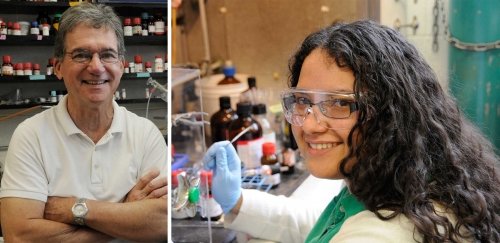A Summer for Scientists: 33 RIC Students Present Research at SURF Conference
- News & Events
- News
- A Summer for Scientists: 33 RIC Students Present Research at SURF Conference

RIC Professor of Chemistry John Williams and his research student Jennifer Rodriguez
Thirty-three RIC scientists-in-training participated in the 2015 Rhode Island Summer Undergraduate Research Fellows (SURF) program, a 10-week curriculum of lab and field research for high-achieving students.
Co-sponsored by the Rhode Island IDeA Network of Biomedical Research Excellence (RI-INBRE) and the Rhode Island National Science Foundation’s Experimental Program to Stimulate Competitive Research (RI NSF EPSCoR), SURF culminates in an annual conference where students present their research before their peers, faculty and administrators.
This year’s conference, held at the University of Rhode Island, featured remarks from Gov. Raimondo, a strong advocate for STEM-related learning.
SURF students consisted of 96 RI-INBRE students and 38 RI NSF EPSCoR students drawn from public and private colleges and universities throughout the Ocean State. Their research was conducted under the guidance of faculty mentors.
“These students lived and breathed science, not as undergraduates trying to make it through their genetics or organic chemistry course, but as active participants in the scientific pursuit of knowledge,” said Jim Lemire, RI NSF EPSCoR coordinator of undergraduate research.
Jennifer Rodriguez, a RIC undergraduate, said she had never worked in a lab prior to her SURF fellowship. She teamed with Franchesca Cruz, another SURF student from URI, and they both worked under principal investigator John Williams, RIC professor of chemistry. Their research involved developing a biochemical technique to measure heat shock in mussels.
“The implications of this research on climate change are interesting,” he said. “As Narragansett Bay warms up – and it has warmed up significantly in the last 50 years – two things are liable to happen. You’ll get higher temperatures that are more frequent and that last longer, resulting in more organisms that are heat-shocked more often and for longer periods.”
This environmental stress can lead to the disappearance of a species, said Williams; therefore, an accurate and precise analytical technique to test for heat shock would be invaluable.
Williams added that heat shock proteins also appear in many early-stage cancers. The same chemical analysis to detect heat shock has implications for early-stage cancer detection, he said. Selective toxicity to cancer cells is Williams’ larger ongoing research project.
After collecting 150 specimens from three sites in Narragansett Bay, Williams’ students dissected the gills, extracted proteins from the cells of the gill tissue and then exposed the proteins to heat shock by placing the proteins in a 104-degree Fahrenheit bath for 20 minutes. Increased temperature stimulated the production of stress proteins.
“After a week and a half of trial and error, and finally achieving our first results, we were ecstatic,” Rodriguez recalled, with a smile. “Franchesca and I ran to Dr. Williams’ office to tell him. Dr. Williams! Dr. Willliams! We did it! We did it! He said, ‘Great job. Now, let’s do it again.’”
Repeating the experiment and getting the same results ensures that the experimental technique is solid and reproducible, Williams said. He would like to develop the technique to the point where it can be used to test for heat shock in animals taken out of the bay at any given time of the year and he’d like to gather longitudinal data on the effects of stress response.
Other SURF poster presentations included a research project by RIC student Nicklaus Collette, which integrated biological, pharmacological, medical and clinical data. Collette worked under principal investigator and RIC Assistant Professor of Psychology Jayson Spas, who is testing new interventions to combat cigarette smoking and excess weight, the first and second leading causes of preventable deaths in the United States.
“Our students are provided valuable biobehavioral research experience to help them secure admission into competitive graduate training programs and eventually launch their own careers as independent researchers and principal investigators,” Spas said.
In another research project led by RIC Professor of Psychology Beverly Goldfield, RIC students Stephanie Chauvin, Alyson Cohen and Esther Quiroz investigated early verb comprehension in 12-, 14-, 16-, 18- and 20-month-old children, using the Preferential Looking Task (PLT).
The PLT measures visual attention to a target versus a distracter image both before and after the target image is identified. Verbs are tested using videos of actors performing actions. Comprehension is defined as an increase in visual attention to the target image during the test trial compared to the baseline trial. Using a Tobii T60XL Eye Tracker system, students were able to record visual attention and conclude that verb comprehension begins well before 18 months of age.
RIC students Danielle Lafond, Saman Nayyab and Victoria St. Amand investigated the effects of genetic mutations that cause amyotrophic lateral sclerosis (ALS), also commonly known as Lou Gehrig’s Disease. Fruit flies were used as test specimens because of their ability to recreate the features of many human diseases. The Principal Investigator was Geoff Stilwell, RIC assistant professor of biology. By introducing the mutation that causes ALS, his students were able to reproduce features of the disease in fruit flies. Their lab work included dissecting the brains of fruit flies and studying the neurons.
“I think the most important outcome of lab research,” Stilwell said, “is that students learn to conduct science and gain critical thinking skills that will serve them well in the future regardless of their career path.”
